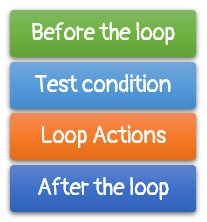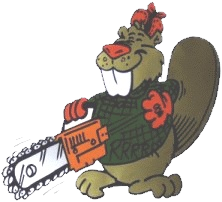How to Write Loops
Writing perfect code the first time is something of a "Holy Grail" among programmers. By that I mean that most programmers long to do it, but the vast majority consider its attainment to be the stuff of legend.
Writing loops is one area where programming errors often crop up. Several years ago, however, I happened upon a technique developed by Doug Cooper, the Berkeley professor of "Oh! Pascal" fame, for building loops. I found that this technique really does increase your chances of building correct loops the first time, and it's worth the effort it takes to learn it.
Goal, Bounds & Plan
The first step in building a successful loop is to be able to describe (and separate) the loop's bound from the loop's goal, and then come up with a plan for reaching your goal.
The bound is the portion that makes it work "mechanically", while the goal of the loop is the work that you want to accomplish. The plan is the strategy you'll follow to both reach the bounds and, if possible, meet your goal.
Here's an example problem that we can use to examine the difference:
How many characters are in a sentence? Count the characters in a string until a period is encountered. If the string contains any characters, then it will contain a period. Count the period as well.
Using this problem statement, you'll find that
- the goal of the loop is to count the characters which precede a period.
- the bounds of the loop are "a period was encountered."
- the plan is to a) "read" a character, and b) increment a counter
We can use the same bounds with a different goal:
Print each character in a string until a period is encountered. Then, add an exclamation point and print a newline.
Notice that the bound is the same, but the goal is different. We're not counting, now we're printing. Our plan would change as well. Instead of adding one to a counter, in step b), we'd simply print the character, and, after the loop is finished, we'd print again.
Implementing the Plan
How do you put your plan into action? What tactics do you use to implement your strategy? Start by looking at the loop topology.

Examine this guarded loop. You can see that there are
- actions that occur before the loop is encountered
- a test that determines whether the loop is entered
- actions that occur inside the loop body
- actions that occur after the loop is complete
These four "faces" of a loop are called the precondition, the bound, the action or operation and the postcondition.
Remember these terms; we'll use them to determine exactly where to start working on our loop.
The Loop Bounds

If you've ever bought a new appliance (like a chain-saw, maybe), the first thing you need to learn is how to turn it off. That's where you should always start writing your loops; ask yourself: What will make this loop quit?
Making sure your loops quit at the right point is the single most important thing that you can do. Let's take our example with the loop bounds written in pseudocode.
// Step 1: Establish the loop bounds
// Before the loop
while letter is not a period
{
// inside the loop
}
// After the loop
The Bounds Precondition
The bounds make sure that you exit the loop at the correct time. Next you have to that make it possible to enter the loop. Step asks "How do I get out?", while Step 2 asks: "How do I get into the loop?" Look at the bounds condition:
while letter is not a period
- What is letter?
- Where did it come from?
- How did it get a value that I can check?
If you were to write the bounds in C++, using your editor, your code would not compile because it refers to variables which don't yet exist. Bounds precondition statements create the variables used in the test, and initialize each to some meaningful state.
// Step 2: The bounds precondition
str <- string supplied to the problem
pos <- 0
letter <- str.at(pos)
while letter is not a period
{
// Inside the loop
}
In our example, str is the string we've been given. We need two variables, pos which is the position (or index) of the character we want to examine, and letter, initialized with the first character in str.
If letter does not contain the first character in str, then you have no assurance that you will ever enter the loop— the value of letter will be unknown. (In C++ it will be some random value.)
Advancing the Loop
Now it's time to advance the loop, which means adding statements to the loop body that move closer to the bounds on each repetition. Let's see why. If you leave the body empty, what will happen?
- If str begins with a period the loop will not be entered. The program works and reports that there are no characters before the period.
- Otherwise, when the loop in entered, nothing in the body changes the value of letter, so there is no way out of the loop; it repeats over and over, endlessly. Endless (infinite) loops are common errors. Your IDE will appear as if it were "hung".
- To avoid endless loops, be sure the statements inside the loop body change something tested in the loop bounds. Here, just store the next character, like this:
str <- string supplied to the problem
pos <- 0
letter <- str.at(pos)
while letter is not a period
// Step 3: Advance the looppos <- pos + 1
letter <- str.at(pos)
At this point, the mechanical portion of your loop—the part
that makes it "work", so to speak—is finished. You should be able to compile
your code (once you've "translated it" into C++, of course), and it should
run correctly.

The Loop Goal

The whole purpose of a loop is to get some real work done, to accomplish the goal. Up until now, we've ignored the goal portion entirely, because we want to make sure the loop works, before we put it to work.
The code to carry out the goal of the loop is written in a different order than that for the loop mechanics:
- start in the precondition area
- move to the operations in the loop body
- then deal with the postcondition
The Goal Precondition
The purpose of every loop is to produce information. Many loops count things and add things, for which you create counters andaccumulators. For this step, create and initialize the variables necessary to carry out the goal of the loop.
Ask yourself: "What information does this loop produce?" Then, create and initialize variables to store that information. In our case, we now need a counter to store that information.
// Step 4: The goal preconditions
str <- string supplied to the problem
counter <- 0
pos <- 0
letter <- str.at(pos)
while letter is not a period
{
pos <- pos + 1
letter <-> str.at(pos)
}
Loop Operations
A loop can have many different goals, so it is hard to generalize about this step. A good start is to look at the variables you created in the last step and ask: "How are these variables processed to produce the desired output?"
Are you calculating a sum, counting different occurrences, or transforming existing values into new values? The statements inside the loop body will almost always update the variables created in the goal precondition in some way.
In our case, we need to increment our counter every time through the loop, since each time we read a character (that isn't a period), we want to count it.
str <- string supplied to the problem
counter <- 0
pos <- 0
letter <- str.at(pos)
while letter is not a period
{
Step 5: The Goal Operation or Action
counter <- counter + 1
pos <- pos + 1
letter <-> str.at(pos)
}
The Postcondition
Loops end when reaching their bounds. not when they've reached the goal! After the loop is over, you have to ask yourself: "Has my loop reached its goal?"
In our case, the problem asked us to count the period as well, and we haven't done that. So, after the loop is over we'll have to add a postcondition statement like this:
str <- string supplied to the problem
counter <- 0
pos <- 0
letter <- str.at(pos)
while letter is not a period
{
counter <- counter + 1
pos <- pos + 1
letter <-> str.at(pos)
}
Step 6: The Loop Postcondition (reached the goal?)
counter <- counter + 1 // count the period
// Now the variable counter contains our goal
Now our loop has correctly counted the number of characters in the first sentence. Or has it? Next we'll look at two small details that I glossed over.
Loop Guards
The problem statement said that the input would have a period if characters were entered. But, what should we do if the input string is empty? We should skip the loop altogether.
You can modify the loop to handle this case by guarding the loop with an if statement.
Guarding the loop for an empty string
counter <- -1
If str is not empty then
{
counter <- 0
. . .
}
If counter is -1 then the goal is not reached
Otherwise counter contains the goal
The counter is set to -1 before the loop guard. After the loop guard, if it still -1 it means that the loop was never entered; you'll have to handle that in the post-condition processing.
Necessary & Intentional Bounds
If we change the problem so that it doesn't include the guarantee that every input string that contains characters will have a period, things are more complicated.
Here is what you need to ask yourself: "Can my loop reach its bounds?"
If there is no period in str then obviously it cannot. It will continue consuming any memory that appears after the string, or, it will crash. Neither are desirable.
A secondary condition designed for such eventualities is called a necessary bound. When we run out of characters, we must stop, even if our intentional bound is not reached. Here's our code modified to handle this complication.
// Adding a necessary bounds
counter <- -1
len <- str.size()
If str != ""
{
counter <- 0
pos <- 0
letter <- str.at(0)
While pos < len and letter is not a period
{
. . .
}
if letter is a '.' then counter <- counter + 1
else counter <- -2
}
If counter is -1 the string was empty
Else if counter is -2 there was no period
Else counter contains the goal
The post-condition now handles three cases: a string with a period, the empty string, and a string with no period.